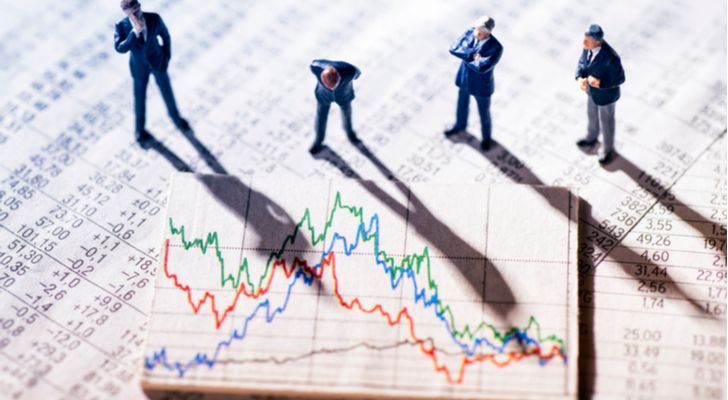
Editor’s Note: Eric Fry, here. Technological progress has forever changed the markets in terms of volatility. Even though stocks have boomed over the past few years, the markets have also suffered 19 out of the worst 20 worst single day drops in 40 years over that time frame.
In short, volatility and flash crashes are the new norm, even in bull markets.
To address this new reality, my InvestorPlace colleague Luke Lango has spent nearly a year building and testing a powerful new tool – called Auspex – to help find the best stocks at the best time. Luke will reveal this new tool at The Auspex Anomaly Event on Wednesday, December 11 at 1 p.m. Eastern time. You can reserve your spot for this event here.
Today, Luke is joining us to discuss why it’s crucial to recognize that market conditions can shift dramatically… why the traditional “buy-and-hold” strategy now requires a more nuanced approach… and share more about his new Auspex tool.
Take it away, Luke…
The stock market just had its best month of the year, with the S&P 500 rallying almost 6% in November.
And no wonder…
From deregulation to tax reform, President-Elect Donald Trump promises to reshape the U.S.’ economy through pro-growth policies. Those promises are stirring investors’ “animal spirits”… and so the market continues to surge higher.
For instance, since Election Day…
- The S&P 500 is up about 6.2%, and it keeps reaching record highs of 6,000 and beyond.
- The Russell 2000 index of small-cap stocks has surged about 9.7%
- The tech-heavy Nasdaq-100 has gained about 7.2%.
- And Bitcoin (BTC-USD) has also risen about 32% – from $70,000 to, just last night, an all-time high of more than $100,000.
Now, we’re all now wondering if this red-hot rally can keep going through Trump’s inauguration and beyond.
I think it can. However, there’s every reason to believe it could sputter out before Trump’s term is over… and maybe even sooner than that
No rally lasts forever. No smart investor can afford to set it and forget it.
That’s why we need strategies that can beat the market in rallies – and in downturns.
And during a special broadcast on December 11, I’m showing to the public – for the first time ever – a new strategy that just does that. (Go here now to sign up and reserve your spot for that event.)
In fact, I’ve been using this strategy live with a select private group of my subscribers for the past five months… and it’s beaten the market each and every single month.
Including November.
So, here today, let’s look at the past in order to see why the current Trump boom may not last as long as we wish.
And I want to take a minute to take a look under the hood of my new strategy.
It takes only a few minutes each month to set up… and you’re done. There’s no need to constantly keep an eye on target prices or stop-losses.
Finally, I’ll show you why I believe my new strategy will keep beating the market month after month – whether we get a Trump boom or bust – and at how you can start using it yourself…
When Buy-and-Hold Doesn’t Always Work
The investment landscape has changed… a lot… over the past several decades.
However, most investors still believe in “stocks for the long haul” – in buying and holding.
They’ve yet to realize how drastically market conditions can shift.
Consider 1962 to 1982.
During this two-decade bear market, the S&P 500 index (the blue line in the chart below) plummeted from 713 to 363, a nearly 50% decline. Buy-and-hold strategies just won’t work in that kind of an environment.

Source: Macrotrends.net
Indeed, not many stories of ordinary workers amassing multimillion-dollar portfolios through patient investing emerged during this era.
In fact, this period of stock market pain resulted in BusinessWeek’s now-famous “The Death of Equities” cover in 1979:

Investing in individual stocks during the 1960s and ’70s was challenging, even for expert stock pickers. Even seemingly safe, industry-leading companies underperformed.
Consider IBM Corp. (IBM), a technology pioneer and popular choice among retail investors. Despite its prominence and innovation, IBM’s performance was pretty cruddy.
Between winter 1962 and fall 1981 (19 years!), IBM produced an average annual return of 2.62%. (And that includes reinvested dividends.)

Source: DQYDJ.com
A $10,000 investment yielding 2.62% annually over 19 years results in $16,346 — hardly enough for a comfortable retirement.
A similar years-long bear market hit us in the 2000s following the dot-com boom and the financial crisis.
Am I predicting something similar now? No.
In fact, a 25-basis-point interest rate-cut remains on the Federal Reserve’s table for later this month – and that should help keep stocks on a winning path.
At some point, however, this rally will end. At some point, postelection euphoria will fade. At some point, investors will look to lock in short-term profits.
We’re not at that point yet. I do think it could arrive by around the inauguration.
Moreover, the world is an “interesting” place. And Donald Trump only makes it more “interesting.”
In the years ahead, we could see global conflicts… rising inflation… soaring interest rates… just about anything.
All of which could put the stock market in a funk. Maybe not a 1960s-’70s style funk… but a bad mood, nonetheless.
However, thanks to my new strategy, investors can still beat the market and make big gains after this rally sells off… or even if we do go into a longer downturn.
Let me show you how…
How to Succeed in Today’s Market
“Buy-and-hold” isn’t dead.
In fact, I recommend my members to buy and hold in artificial intelligence, precision medicine, quantum computing, and nuclear energy stocks. Those megatrends – and others – still have plenty of potential for long-term growth.
This is still the best way to build a multimillion-dollar portfolio – and a life of wealth and peace – over decades of time.
However, between frequent flash crashes and constant market turbulence, investors face many challenges when it comes to short-term gains.
We need to diversify our investing strategies beyond buy-and-hold.
That’s why I also encourage my subscribers to use more active trading approaches to capitalize on market volatility.
And it’s why we developed my new Auspex strategy – to replace uncertainty and volatility with certainty and stability.
It’s why I’m showing everyone who signs up a lot more about it during The Auspex Anomaly Event on Dec. 11 at 1 p.m. Eastern.
To me, Auspex is the ultimate stock-screening tool. My team and I designed it to find the “best stocks at the best time.”
Auspex combines fundamental, technical, and market sentiment factors to identify the next month’s top-performing stocks.
At the start of each month, Auspex scans more than 10,000 stocks to for those with the highest levels of fundamental strength, technical market direction, and positive market sentiment… to find the stocks with the most upward momentum over the next month.
It typically identifies 5-20 stocks. Then, my team and I then dig in and determine which of those will form that month’s Auspex Portfolio.
We started doing this live for a small group of my members five months ago. And we’ve seen market outperformance – sometimes outstanding outperformance — each and every month since then.
November was a great month for stocks, with the S&P 500 rising 5.7%.
However, Auspex crushed it, with our equal-weighted portfolio rising more than 8%.
Again, this was the fifth consecutive month of market-beating returns for Auspex.
Moreover, back-testing shows Auspex outperforming the market by 10X-plus in trailing 5-, 10-, 15-, and 20-year windows.
In our April 2024 back-test scan, Auspex identified Dynagas LNG Partners LP (DLNG) and Zeta Global Holdings Corp. (ZETA) as having huge momentum behind them.
And in April, DLNG stock popped almost 30%, while ZETA rose about 15%. Over that same stretch, the S&P 500 dropped about 4%.

In our May back-test scan, Auspex continued to highlight DLNG and ZETA. In May, ZETA soared more than 30%, while DLNG popped almost 10%. The S&P 500 rose just 4%.

To put it simply: Two Auspex stocks — DLNG and ZETA — rose about 40% and 50%, respectively, at a time when the market was basically flat.

The Bottom Line
In 2025, the stock market is going to be volatile and complex… and it’s going to change all the time… just like 2024, 2023, 2022, etc.
In this environment, tools that provide data-driven, adaptive investment strategies will be invaluable.
That’s why we developed Auspex…
With it, investors can position themselves to not just weather potential market storms but to thrive and potentially achieve returns far beyond market averages.
To learn more, just click here to sign up for The Auspex Anomaly Event. Then mark your calendar for Wednesday, December 11, at 1 p.m. Eastern.
Hope to see you there!
Sincerely,
Luke Lango
Editor, Hypergrowth Investing





